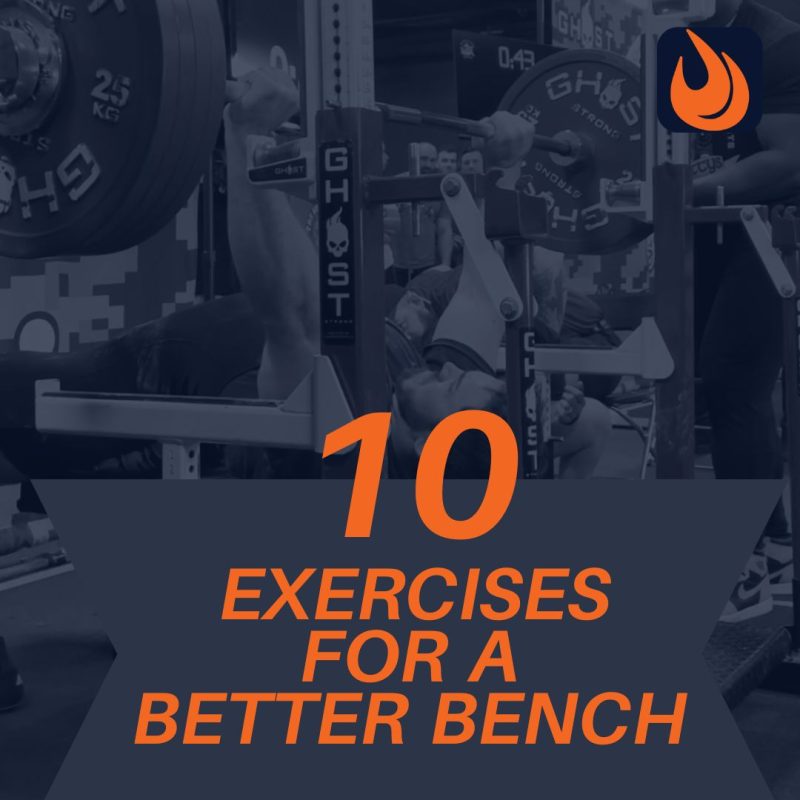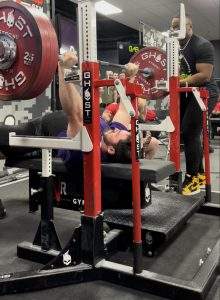
‘How much do you bench?’ is possibly the most frequently asked question in weightlifting circles. Regardless if an individual is a burgeoning personal trainer, a weekend warrior, professional athlete, or elite powerlifter, everyone wants to know the answer. The great upper body power and a formidable physique that goes hand-in-hand with a big bench press are why the bench is used as the standard test of upper body strength. To optimize pressing strength, however, benching alone is not enough, and implementing the right assistance movements is key. This article will discuss the 10 best exercises to build a better bench and move more weight.
Choosing the Best Exercises for a Better Bench
The importance of specificity must be remembered when endeavoring to build a better bench. The more the training method is specific to the goal in mind, the more the training will carry over to attain that goal. Therefore, the best exercise to build a better bench is bench pressing itself. A properly structured program with progressive overload and the bench as the primary movement is the most effective way to build a better bench.
Conversely, the principle of variability plays just as important of a role as specificity. Variability in training is necessary to progress because it gives the body a reason to adapt. The law of progressive overload itself is a form of variability done by changing the weight, sets, reps, and rest intervals as is customary in a thoughtful periodization program. Variability also comes into play with choosing the appropriate exercises to conduct during a training session.
Only benching one way may be impractical to implement or simply not enough. Overuse injuries and plateaus can occur due to the repetitive motion of training a movement pattern with the same exact exercise day in and day out. Variability in accessory exercises provides a different stimulus to achieve the same goal. A new stimulus can have a greater effect toward building strength and negate some issues of repetitive motion. This list of the 10 best exercises to build a better bench provides great variability all while supporting the lifter’s pressing strength.

1. Paused Bench Press
The paused bench is a great way to build up pressing power. Everything about the movement is the same other than increasing the time under tension and the control needed to execute the movement. To perform the pause bench, set-up as normal but pause the bar at the chest instead of performing a touch-and-go rep. The pause will eliminate some of the stretch reflex that happens during a touch-and-go rep and create more difficulty as the musculature is in the stretched position longer. This will require greater force to be generated to press the weight.
2. Switching width grip positions
Switching the grip width on the bench is great to avoid overuse injuries that come with repetitive movement and to emphasize a lagging muscle. Moving the grip width in will place greater tension on the triceps, while moving the grip width out will place greater tension on the chest. If the lifter is having trouble at the top of his bench press, focusing on the triceps with a close grip will increase that lock-out strength. If the lifter is lacking explosive strength off his chest, a wide grip will help develop that chest pop.
3. Banded Bench Press
The banded bench is a form of accommodating resistance and is an excellent movement to add to a bench-building arsenal. Accommodating resistance means that the resistance experienced by the lifter matches the strength curve of the lifter during the movement. For instance, during a normal bench with ‘straight weight’ the muscle is the most challenged during the middle of the lift, where the leverages are the least advantages, this is called the ‘sticking point.’ As the lifter presses up past the ‘sticking point’, however, he will be able to generate much more force than what is on the bar.
Additional resistance such as bands or chains will accommodate for the strength curve and provide extra resistance at the top of the movement. This trains the lifter to generate force throughout the entire rep, producing a more powerful presser. To set up, attach the bands to the bar and the floor/rack. The band should be in-line with the shoulders at the ‘lockout’ position and not too far up or down. Perform the bench with the intention of creating power all the way through the rep, expecting the increased resistance at the top.
4. Dead Bench
The dead bench is performed with the starting position at the bottom of the bench. Set the bench press up in a power rack and place the safety pins just high enough that the bar will rest 1-3 inches off the lifter’s chest in the bottom position. The lifter should set-up as normal except the press will start with the bar at the chest. The lifter will only perform sets of one to focus solely on the concentric power, as performing multiple reps will just re-introduce to the eccentric phase. Lifters that have great control during the negative but either lose tightness or lack the strength during the press should implement the dead bench to build the positive portion of the lift.
5. Dips
Although not a barbell and bench movement, the dip is one of the best assistance exercises to the bench press. The position of the chest and the stretch on the triceps mimics the bench press and provides optimal carry-over. A great presser should have no trouble dipping their body weight with a load of iron hanging from a dip belt. If a lifter struggles with dips it is no surprise they struggle with the bench.
To set up, position the dip bars at a comfortable level where any weight hanging from a dip belt will not hit the ground. Jump or step up into the starting position, maintaining good core control to prevent swinging or thoracic spinal flexion. Lean the torso forward to make the dip more of a downward press and lower the body till the elbows hit at least 90 degrees. Press back up to finish the rep. To build a strong bench it would be a huge mistake not to incorporate heavy dips into the program because of their excellent carry-over to a better bench press.
6. Decline Bench Press
The Decline Press calls on similar mechanics to the dip and is a tremendous place to start for those struggling to perform the dip. The decline press emphasizes the lower chest fibers due to the pressing angle, and is a great option for those lacking chest development. Position the bench into a decline and perform the press. Be extremely cautious and always use a spotter if safety pins are not provided.
7. Incline Press
The incline press is a great option for lifters struggling during the middle of the press, as it develops the upper chest fibers and shoulders to carry over into the bench. For lifters struggling with lock-out, a close grip position taken on the incline press will place tremendous emphasis on the triceps. To set-up, either position an adjustable bench to about 30 degrees or find a standard incline bench. Perform the movement focusing on the target muscle.
8. Overhead Press
The overhead press is a great exercise to develop lagging shoulders on the bench. Lifters should keep their ribs stacked over their pelvis to ensure a neutral spine, maintain soft knees, engage the core, and keep the load on the movement in the deltoid as they press. Lifters struggling during the middle and lock-out portion of the bench could find great benefit in training the overhead press.
9. Switching to dumbbells
Dumbbell benches are a great accessory to building a better bench press. Dumbbells can be used to press in the most comfortable shoulder position and get a greater range of motion through the entirety of the exercise. The barbell limits pectoral range of motion in two ways; the first is at the bottom when the barbell prevents lowering the weight any further down past the chest. The second way is at the top, as the fixed hand position prevents the lifter from converging the pectoral fibers fully toward the midline of the chest.
In order to get the hypertrophic stimulus from these two missing aspects, adding in some supplementary dumbbell work in addition to the traditional bench is key. Dumbbells also provide a greater challenge to the shoulder’s ability to stabilize since the glenohumeral joint requires all of the supporting soft tissue structures to be recruited to prevent the dumbbell from falling in any of the three planes of motion; because of this added challenge, personal training clients will not be able to handle the same weight with dumbbells as they do with a barbell.
10. Push-up
The push-up should never be overlooked for building a big bench if you know how to implement it correctly. Shoulder issues often come from instability and weakness at the joint, but the standard push-up can be used to strengthen the supporting pressing musculature. Unlike the bench, the push-up is a closed-chain exercise, meaning that the lifter’s hands are not in free motion but are in contact with a stable surface.
This stability at the hands allows for more concentration and motion at the shoulder joint. Scapula protraction and retraction can both occur more easily with a standard push-up than a bench press, where limited protraction is needed. This scapular movement trains the supporting shoulder joint musculature to keep the lifter’s shoulders healthy. Adding a proper push-up to the warm-up or end of a session as a finisher is a fantastic training method to build a better bench!
Bench Variation= a Better Bench
To get the most out of these press variations to build a better bench, the lifter or coach needs to identify the weakness the lifter is facing. If the lifter is explosive off the chest but struggles at lockout, training wide grip barbell presses for the chest is not the best use of their time, but instead more focus should be on building the triceps with close grip variations. Select the best of these exercises for that lifter and implement them in their next upper body training day.






